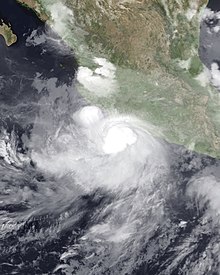 Andres at peak intensity on June 23 | |
| Meteorological history | |
|---|---|
| Formed | June 21, 2009 |
| Dissipated | June 24, 2009 |
| Category 1 hurricane | |
| 1-minute sustained (SSHWS/NWS) | |
| Highest winds | 80 mph (130 km/h) |
| Lowest pressure | 984 mbar (hPa); 29.06 inHg |
| Overall effects | |
| Fatalities | 3 direct, 2 indirect |
| Damage | $231,000 |
| Areas affected | Mexico, Honduras |
| IBTrACS / [1] | |
Part of the 2009 Pacific hurricane season | |
Hurricane Andres was the first named storm and hurricane of the 2009 Pacific hurricane season. Forming on June 21, Andres gradually intensified as it tracked along the Mexican coastline. Deep convection developed around the center of circulation and by June 23, the storm attained hurricane-status, peaking with winds of 80 mph (130 km/h). Upon attaining this intensity, the storm featured a developing eyewall within a central dense overcast. Within 36 hours, the storm rapidly degenerated, having most of the convection being displaced by high wind shear, becoming a non-tropical trough during the afternoon of June 24.
Prior to becoming a tropical depression, Andres produced heavy rainfall in Oaxaca and Honduras, resulting in two deaths. Rough seas off the coast of Guerrero resulted in one fatality. Inland, flooding caused by heavy rains killed two additional people. An additional 20 people were injured. Several dozen structures were damaged and a few were destroyed. Total losses from the hurricane reached MXN 3 million ($231,000 USD) in Colima. Following the storm, roughly 350 people were left homeless.